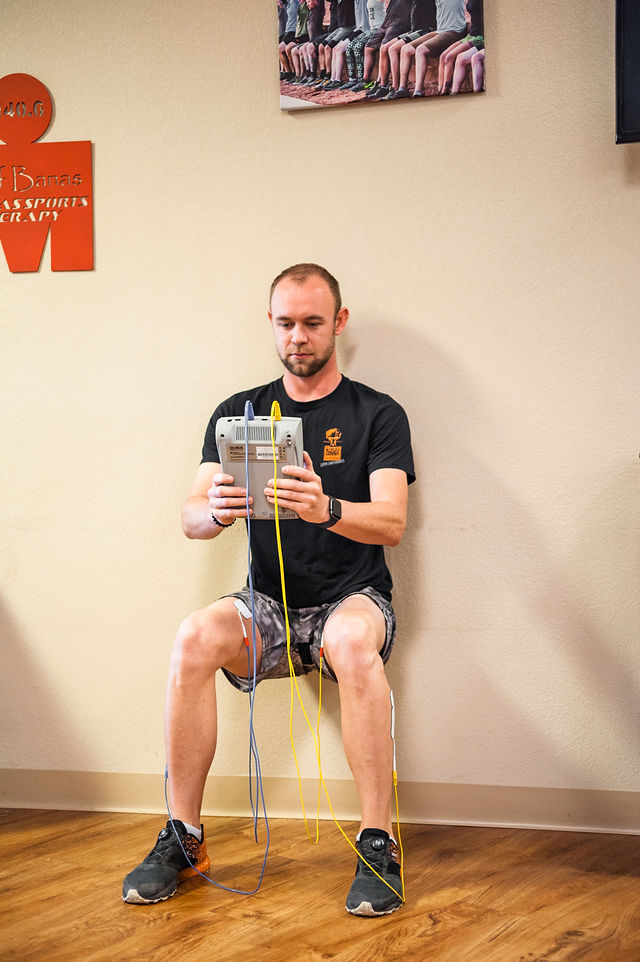These can be used for muscle activation, nervous system training, and strength training.
The Phoenix Waveform can allow you to effectively strength train without putting stress on a joint.

For example, lets say someone has a bad knee but lifting weight puts too much pressure on the bad knee joint. The Phoenix Waveform can be put on the surrounding muscle and we can have those muscles contracting at 500 contracts a second with NO PRESSURE on the knee itself. In addition to strengthening the muscles around the knee, we are also enhancing neuro-muscular connections by sending the brain feedback on the muscle’s movements.
The unique nature, and deeper penetration, of the Phoenix Waveform, allow it to be used while the client is in a full range of motion. Based on our experience movement directs the Phoenix Waveform to the point of injury much more effectively than when the client is in a stationary position. The Phoenix Waveform now is able to allow the muscles to contract and have to go through eccentric (lengthening the muscles while they are contracting) motions while being stimulated, allowing an almost instant increase in ranges of motion.
Most injuries are caused because your body can not absorb the forced placed on the muscle or joint.
For this reason, we now need to train the nervous system and muscles to absorb force when it is applied. Failure to do this will likely result in a re-injury.

The nervous system controls every muscle movement. It’s not big muscles do not make you throw faster or run faster. The reason someone can run faster, jump higher, or is more athletic is that their brain and nervous system are better.
Our technology re-educates and enhances the neuromuscular connection allowing your body to absorb force (Like landing from a jump or running). When you train the nervous system everything is better. It’s not bigger muscles that make someone an athlete.
If you train your nervous system, you will likely have less pain, a better range of motion, improve your daily living activities, and improve and enhance your athletic abilities.
Exercise Protocols based on targeting specific muscle groups.
STRONG POINT: We contraction the muscle with the Phoenix then we lengthen the muscle (an Eccentric Contraction)
Perform all movements slowly, then gradually increase the intensity of the muscle stimulation from the Phoenix Wave. Repeat the movements for 5 to 15 min.
You can also place the electrode pad just on the muscle belly you want to work and then take that muscle through it’s range on motion while increasing the stimulation intensity.
A good time to do these strength exercises are after you have done other “normal” strength training or after your muscle are fatigued from another type of strength training or exercise session. Think of it as getting a few more reps, thereby allowing you to train harder.
As a guide or reference on which exercises to do, go to your specific sport, look at the key muscles used in your sport, then perform the exercise movements below which are associated with your sport’s specific muscle group.
Adductors and Erector Spinae
Black Pad on the lower back just above the iliac crest
Red Pad on upper adductors
Movement:
Hold the weight at chest level
Slowly squat down with knee and shoulder with apart
Slowly stand up and rotate the trunk 90 degrees to the right, then 90 degrees left.
Take a big side step to the right, hold weight at chest level
Slowly squat down in a wide stance
Bring legs back to shoulder apart
Squat down and up
Take a big side step to the left
Glutes and Quads
Black Pad on Gluts.
Red Pad on Quads
Movement:
Slow squats while holding the weight straight in front of the chest.
Perform a “Functional Pattern” Lunge Right
Perform a “Functional Pattern” Lunge Left
Hamstrings And Gastrocnemius
Black Pad on hamstring
Red pad on Gastrocnemius
Movement:
Lay supine on the ground, feet on a swiss ball in the hamstring ball curl “finish position with toes flexed towards you.
Slowly extend the hamstrings, keeping the gluts off the ground and plantar flexing the toes
Hold this position for 20-30 sec
Slowly flex the hamstring by pulling the swiss ball back toward your gluts, while dorsiflexing the feet
Psoas (Hip Flexors) and Abdominal Muscles
Black Pads on Abdominal
Red Pads over Psoas
Movement:
Raise the knee so that the thigh is parallel to the ground
Curl your truck as if you are trying to touch your knee to your chest. ***Make sure you are curling the trunk and not flexing the trunk.
No stand tall, extend the lumbar spine slightly while extending the knee behind you.
Repeat 5 times then move to the other leg
Biceps and Forearm
Black Pad on Biceps
Red Pad on Forearm
Movement:
It is a good idea to be holding something in your hands. Here he is holding a tennis ball.
Extend the biceps
Once in full extension
Extend the wrist
Do a biceps curl
Flex the wrist